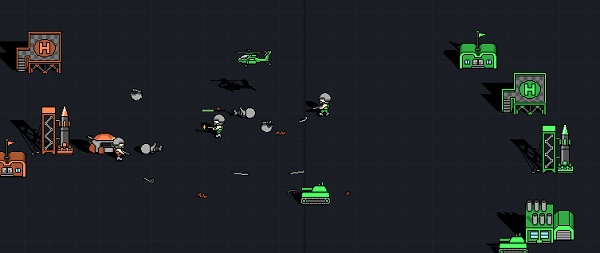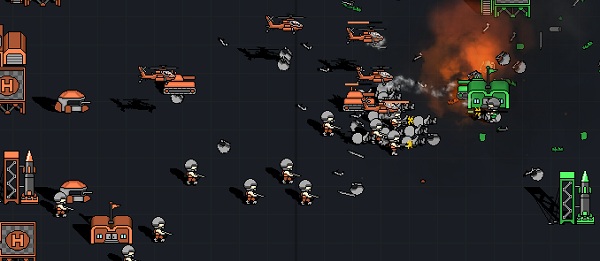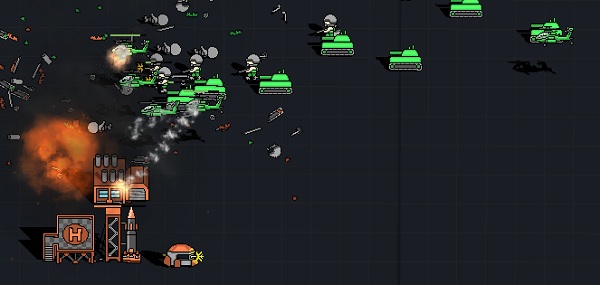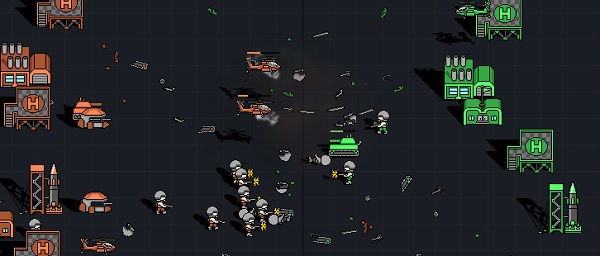Mutual Assurance Society: Fail-Deadly
More free gaming to set you up for the weekend. Even if you enjoyed the Pacman stylings of the earlier duo, that's not to say you won't also enjoy the Advance Wars meets Defcon horrors of Fail-Deadly. It is, at its core, one of the most horrible games I've ever played. It's also remarkably entertaining. Two forces are at war and you are a terrible person at the head of a terrible organisation who wants nothing more than a stalemate between them. Your goal isn't to bring about a state of everlasting war though; you really are a nasty piece of work and what you want is a conflict so evenly matched and soul-sapping that the participants turn to the last resort. Nuclear destruction. Free to download.
Fail-Deadly has grown out of a Ludum Dare entry that was the first pick in the competition back in August 2010. Based on the theme enemies as weapons, its creator Josh Sutphin picked up the idea of using two armies against each other, two cultures even, and ran with it. Then he took it into the middle of no man's land, planted it among the ruined, charred corpses of the combatants set against each other, clambered atop the hollowed hulk of a tank, its innards fused together into a mass of the organic and inorganic. There, he fell to his knees and let out an almighty roar of triumph.
Probably. He may actually have put in the hours to rework the visuals and tweak the design in order to make the game more satisfying. Either way, the final result is brilliantly compelling.
Every game starts with two missile silos, one at either side of the screen. You want them to unleash their sickening payload, there's no question about that, but you can't simply break in and punch in a launch code because you are a cursor hovering above the soon-to-be killing grounds below.
In the bottom left of the screen, a little box fills with a building or powerup. The buildings either produce units or act as defensive turrets while the powerups boost speed of production, weapon damage or armour value for an entire army. To decide who receives the building or unit, you place them on the left or right sides of the screen. Place it on the right, it belongs to that army, place it on the left and it belongs to their sworn enemy. Units roll off the production line and trundle to the opposite side of the screen in a bid to destroy the opponent's silo.
But, remember, you want stalemate. So the next building should sit on the other side. That way, a huge battle will break out in the middle of the screen, corpses littering that central wasteland and leaving the silos untouched. But then unbalance occurs. Tanks begin to pop infantry soldiers far too easily and the carnage tips toward the right hand side of the screen, so you drop the next research powerup, the most dangerous of all which boosts production speed, deep to the right. Suddenly there are twenty soldiers charging the left-hand silo.
Let's say two helipads arrive next. They have to go to the left to stave off the flood of soldiers. Stalemate resumes, napalm falls, smells like victory - or the victorious lack thereof. But no. You can't stop placing the factories and powerups that arrive because that also leads to 'game over' so suddenly you find yourself powering up the army to the right so much that it is a numerically inferior but technologically superior blitzkrieging horrornaut.
The scales eventually tip too far and as soon as buildings are constructed, they are destroyed by the oncoming hordes. One army is suppressed, their weapons of mass destruction dismantled. The silence of peace is deafening in your malicious ears. Yes, even your ears are malicious, you despicable death-dealer.
I haven't even talked about the sweet relief that washes over me when an airstrike drops into the box, allowing me to cull both armies as they fight over those inches of land, their purpose and ideological conviction vanishing in a puff of smoke.
It's like having weights thrown at your face as you attempt to catch them and place them on a pair of scales, which are balanced over two buttons linked to the electricity supply that provides juice for the chair that you're inexplicably strapped into. It's also, as others have mentioned, a little like Tetris. A little.
I've 'won' a couple of times. It's a despicable feeling. I'm going to try again right now. So should you.
Spotted at Edge.




